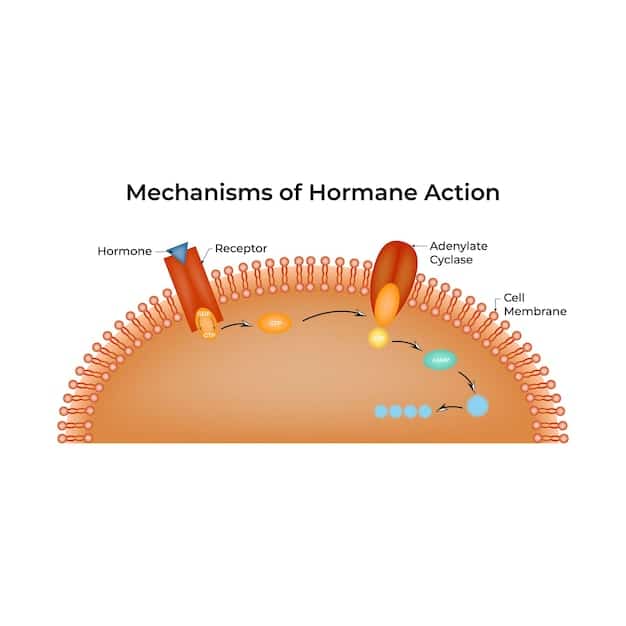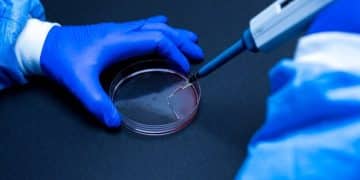Finasteride: Permanent Side Effects and 2025 Risks Explained

Finasteride, a medication commonly used to treat hair loss and benign prostatic hyperplasia, may potentially cause permanent side effects in some individuals, necessitating a thorough understanding of the risks associated with its use, particularly as we approach 2025.
Is can finasteride cause permanent side effects? Understanding the risks in 2025 is crucial for anyone considering or currently using this medication. While finasteride is effective for treating hair loss and prostate enlargement, its potential long-term impacts warrant careful consideration and awareness.
Understanding Finasteride: Uses and Mechanism
Finasteride is a prescription medication primarily used to treat two common conditions. It’s essential to understand its uses and how it works to appreciate the potential risks associated with its use.
Conditions Treated by Finasteride
Finasteride is primarily prescribed for:
- Male Pattern Baldness (Androgenetic Alopecia): It reduces hair loss and promotes hair regrowth in men.
- Benign Prostatic Hyperplasia (BPH): Known as enlarged prostate, finasteride helps shrink the prostate gland, alleviating symptoms like frequent urination and difficulty urinating.
How Finasteride Works
Finasteride functions by inhibiting the enzyme 5-alpha reductase, which converts testosterone into dihydrotestosterone (DHT). DHT plays a significant role in:
- Hair Loss: DHT can shrink hair follicles, leading to hair thinning and eventual baldness.
- Prostate Enlargement: DHT stimulates the growth of prostate cells, contributing to BPH.
By reducing DHT levels, finasteride can slow down hair loss and shrink the prostate gland, thus alleviating the symptoms of these conditions. However, this hormonal manipulation can also lead to side effects.

Understanding the mechanism through which finasteride works is vital for assessing the potential risks and benefits of the medication. The reduction of DHT can have various effects, and it’s essential to be aware of them.
Common Side Effects of Finasteride
While finasteride is effective for treating hair loss and BPH, it is associated with several common side effects. Understanding these potential issues is essential for making an informed decision about using the medication.
Sexual Side Effects
- Erectile Dysfunction (ED): Difficulty achieving or maintaining an erection.
- Decreased Libido: Reduced sexual desire.
- Ejaculation Disorders: Problems with ejaculation, such as decreased volume.
Other Common Side Effects
- Depression and Anxiety: Mood changes and mental health issues.
- Breast Tenderness or Enlargement (Gynecomastia): Development of male breasts.
- Skin Rash: Allergic reactions and skin irritations.
These side effects are generally reversible upon discontinuation of the medication. However, some individuals report persistent issues even after stopping finasteride, leading to concerns about potentially permanent effects.
Awareness of these common side effects is critical for anyone considering finasteride. Patients should discuss these potential risks with their healthcare provider to weigh the benefits against the potential drawbacks.
The Controversy: Persistent Side Effects Post-Finasteride Syndrome (PFS)
One of the most significant concerns surrounding finasteride is the possibility of persistent side effects, often referred to as Post-Finasteride Syndrome (PFS). This condition involves symptoms that linger even after discontinuing the medication.
What is Post-Finasteride Syndrome (PFS)?
PFS is a condition characterized by a range of persistent side effects, including:
- Sexual Dysfunction: Ongoing ED, decreased libido, and ejaculation problems.
- Cognitive Impairment: Difficulties with memory, concentration, and mental clarity.
- Mental Health Issues: Persistent depression, anxiety, and suicidal thoughts.
The existence and prevalence of PFS are subjects of debate within the medical community. Some experts argue that the symptoms are psychosomatic or caused by other underlying conditions, while others acknowledge the potential for genuine, persistent side effects.

The controversy surrounding PFS highlights the need for further research and understanding. Patients experiencing persistent symptoms after stopping finasteride should seek comprehensive medical evaluation and support.
Research and Studies on Long-Term Effects
The exploration of finasteride’s long-term effects has been a subject of ongoing research. While some studies suggest the side effects are generally reversible, others indicate the potential for more lasting consequences.
Overview of Key Studies
Several studies have explored the long-term impacts of finasteride. Here’s a brief overview:
- Reversible Side Effects: Some research indicates that most side effects resolve within a few weeks to months after stopping finasteride.
- Persistent Symptoms: Other studies and case reports suggest that a subset of individuals experience persistent sexual, cognitive, and psychological symptoms, even years after discontinuation.
Challenges in Research
Researching the persistent effects of finasteride can be challenging for several reasons:
- Variability in Reporting: Subjective nature of symptoms and inconsistencies in reporting make it difficult to quantify and assess the condition accurately.
- Study Design Limitations: Challenges designing robust, long-term studies with appropriate control groups.
- Underlying Factors: Differentiating between finasteride-induced symptoms and other potential contributing factors (e.g., age, psychological conditions).
Acknowledging these limitations is crucial when interpreting the available research. Further investigation is needed to determine the true extent and nature of long-term side effects.
Despite the challenges in research, it’s essential to maintain transparency and continue to investigate the possible link between finasteride and persistent symptoms. Better research methodologies plus more extensive long-term studies involving larger sample sizes should produce valuable information in the future, which should inform clinical decisions and patient education.
Risk Factors and Predispositions
Identifying potential risk factors can help individuals make more informed decisions about using finasteride. Certain predispositions might increase the likelihood of experiencing persistent side effects.
Genetic Factors
Genetic variations may influence an individual’s response to finasteride. Some people might be more susceptible to hormonal imbalances or have a heightened sensitivity to changes in DHT levels.
Psychological Factors
- Pre-existing Mental Health Conditions: Individuals with a history of depression, anxiety, or other mental health issues may be at higher risk of experiencing psychological side effects from finasteride.
- Stress and Anxiety: High levels of stress can exacerbate side effects and contribute to the development of persistent symptoms.
Other Health Conditions
Certain medical conditions or medications might interact with finasteride and increase the risk of side effects. It’s essential to disclose your complete medical history to your healthcare provider before starting finasteride.
Understanding these risk factors can help healthcare providers identify individuals who might be more vulnerable to experiencing long-term effects. Personalized risk assessments can improve patient safety and informed decision-making.
Managing and Mitigating Risks in 2025
As we approach 2025, advancements in research, monitoring, and treatment strategies can improve the management of finasteride-related risks.
Enhanced Monitoring Strategies
Implementing comprehensive monitoring strategies can help identify potential side effects early on. These strategies might involve:
- Baseline Assessments: Conducting thorough evaluations of sexual function, cognitive health, and mental well-being before starting finasteride.
- Regular Follow-ups: Scheduling frequent check-ups to monitor for any changes or emerging symptoms.
Potential Treatments and Interventions
Research into potential treatments for persistent side effects is ongoing. Some possible interventions include:
- Hormone Therapy: Addressing hormonal imbalances that might contribute to prolonged symptoms.
- Cognitive Behavioral Therapy (CBT): Providing psychological support and strategies for managing cognitive and mental health issues.
The future of managing finasteride-related risks involves personalized approaches that take into account individual risk factors and preferences. Shared decision-making between patients and healthcare providers is crucial for optimizing outcomes.
Alternative Treatments for Hair Loss and BPH
Given the potential risks associated with finasteride, many individuals explore alternative treatments for hair loss and BPH. Several effective options are available, ranging from topical solutions to minimally invasive procedures.
Alternatives for Hair Loss
- Minoxidil (Rogaine): A topical solution that stimulates hair growth.
- Low-Level Laser Therapy (LLLT): Uses light to stimulate hair follicles.
- Hair Transplant: Surgical procedure that involves transplanting hair follicles from one area of the scalp to another.
Alternatives for BPH
- Alpha-Blockers: Medications that relax the muscles in the prostate and bladder neck.
- Tadalafil (Cialis): A phosphodiesterase-5 (PDE5) inhibitor that can help improve BPH symptoms.
- Minimally Invasive Procedures: Options such as transurethral microwave thermotherapy (TUMT) and laser prostatectomy.
When considering alternatives, you should meet with your healthcare provider to discuss your options. Understanding the risks and benefits of different medicines can help you make informed decisions about your particular medical care.
The decision to consider alternative therapies depends on one’s personal values and preferences. Some people may prefer non-chemical interventions, while others may want a treatment with less risk of known side effects, like cognitive dysfunction.
| Key Point | Brief Description |
|---|---|
| 💊 Uses of Finasteride | Treats male pattern baldness and benign prostatic hyperplasia. |
| ⚠️ Common Side Effects | Includes sexual dysfunction, depression, and breast enlargement. |
| 🤔 Post-Finasteride Syndrome | Persistent symptoms after discontinuing the medication. |
| 🌱 Alternative Treatments | Minoxidil, laser therapy, alpha-blockers. |
Frequently Asked Questions
▼
Finasteride is a medication primarily used to treat male pattern baldness (androgenetic alopecia) and benign prostatic hyperplasia (BPH), also known as an enlarged prostate. It works by reducing the production of dihydrotestosterone (DHT).
▼
The most common side effects include sexual dysfunction (such as erectile dysfunction and decreased libido), depression, anxiety, and breast tenderness or enlargement (gynecomastia). Not everyone experiences these side effects.
▼
Post-Finasteride Syndrome (PFS) refers to persistent side effects that continue even after discontinuing finasteride. These can include sexual dysfunction, cognitive impairment, and mental health problems.
▼
While many side effects resolve after stopping the medication, some individuals report persistent symptoms. The reversibility of side effects can vary from person to person, and more research is required.
▼
Alternatives for hair loss include minoxidil, low-level laser therapy and hair transplants. For BPH, alternatives consist of alpha-blockers, tadalafil, or minimally invasive procedures like TUMT or laser prostatectomy.
Conclusion
Understanding the potential risks associated with finasteride, particularly the possibility of long-term or permanent aftereffects, is crucial for informed decision-making. As medical research advances, comprehensive patient care and management strategies should remain a priority.





